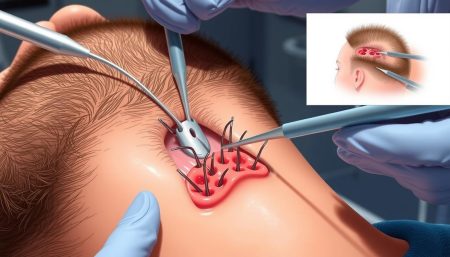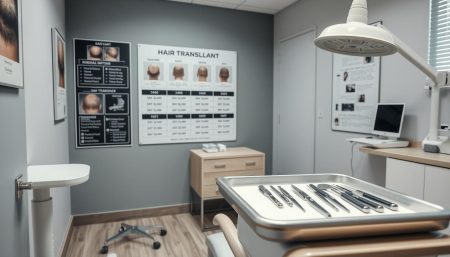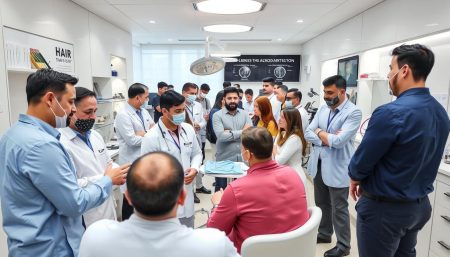Hair loss can really affect how we feel about ourselves. It can change our self-esteem and how we live our lives. The NHS knows this and offers hair transplant services to those who need them in the UK. This guide will look at the different nhs hair transplant options and treatments available through the National Health Service.
The NHS offers many hair loss treatments, from advanced surgery to non-invasive methods. Knowing about these options is important if you’re thinking about getting a nhs hair transplant. This article will explain the process, who can get help, and what to expect from NHS-funded hair restoration services.
Understanding Hair Loss and Its Impact on Mental Health
Hair loss can deeply affect a person’s mental wellbeing, causing significant distress. It’s not just about how you look. It changes many parts of your life.
Psychological Effects of Hair Loss
People who lose their hair often feel less confident and have lower self-esteem. This can lead to anxiety, depression, and even pulling away from friends and family. The emotional pain of losing hair is often overlooked, making it key to treat hair loss for mental health.

Social and Professional Implications
Hair loss can make socialising and work harder. Some might stay away from social events or feel less able to compete at work. This can cause isolation and missed chances, showing why treating hair loss early is vital.
Gender-Specific Hair Loss Challenges
Men and women face different hair loss challenges. Women often feel more pressure about their hair, which can have a bigger impact on their mental health. Men might worry about losing their masculinity or looking older.
| Gender | Common Challenges | Psychological Impact |
|---|---|---|
| Women | Societal beauty standards, limited hairstyle options | Higher rates of anxiety and depression |
| Men | Perception of ageing, masculinity concerns | Lower self-esteem, social withdrawal |
It’s important to understand these impacts to create effective hair loss treatments. These should help both the physical and mental sides of hair loss.
NHS Hair Transplant: Services and Availability
The National Health Service (NHS) in the UK provides hair transplant services. But, these services are not available to everyone. They are mainly for those with severe hair loss due to medical reasons or trauma.

To get an NHS hair transplant, you must meet strict criteria. This includes:
- Hair loss caused by burns or injuries
- Alopecia resulting from cancer treatment
- Severe psychological distress due to hair loss
The NHS offers two main hair transplant methods:
- Follicular Unit Extraction (FUE)
- Follicular Unit Transplantation (FUT)
Waiting times for these procedures can be long, over 18 months. The availability of these services varies by region.
The NHS usually doesn’t cover hair restoration for pattern baldness. If you’re looking for this, you might need to look into private options.
“NHS hair transplant services are a valuable resource for those with medically-necessary hair restoration needs, but access is restricted due to high demand and limited resources.”
If you’re eligible, an NHS hair transplant can be a cost-effective choice. Talk to your GP to see if you qualify and to get a referral.
Qualifying for NHS-Funded Hair Restoration Treatment
The NHS provides hair transplant services to those who qualify. But, the rules are strict. Whether you can get treatment depends on your health and how it affects you.
Medical Eligibility Criteria
To get NHS-funded hair restoration, you must meet certain medical standards. These include:
- Severe hair loss due to burns or trauma
- Hair loss from cancer treatments
- Congenital conditions causing significant baldness
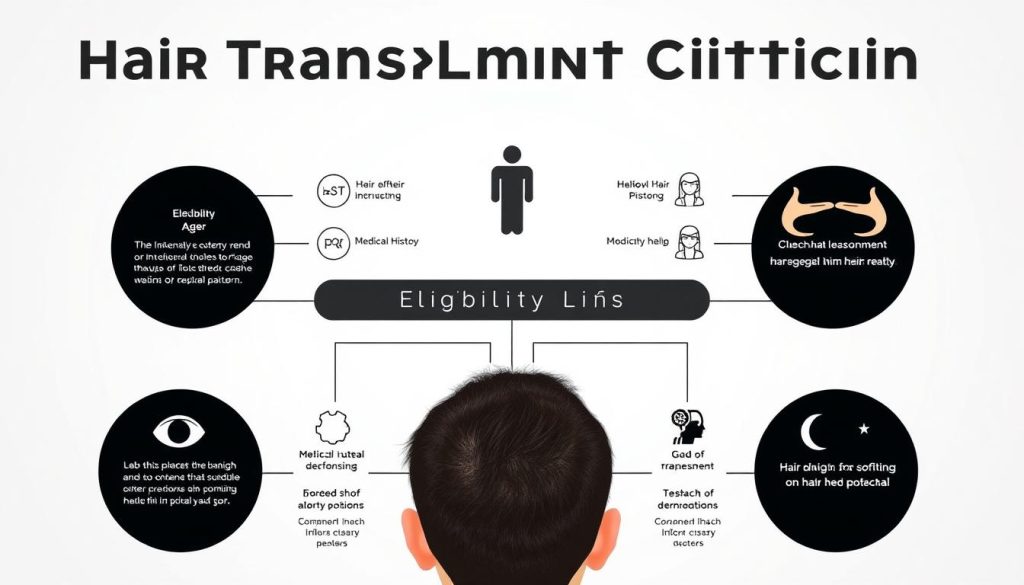
Priority Categories for Treatment
The NHS treats patients based on their medical needs. Those with the worst cases and biggest emotional impact get treated first. Mental health checks might be part of the process.
Application Process and Waiting Times
Getting NHS hair restoration involves a few steps:
- Consultation with a GP
- Referral to a specialist
- Assessment of hair transplant eligibility
- Approval or rejection of the application
Waiting times can be long. They can range from months to over a year. This depends on NHS resources and how many people need treatment.
Types of Hair Transplant Procedures Available
The NHS offers two main hair restoration surgery techniques. These aim to help those with hair loss regain confidence. They work for different types of alopecia.
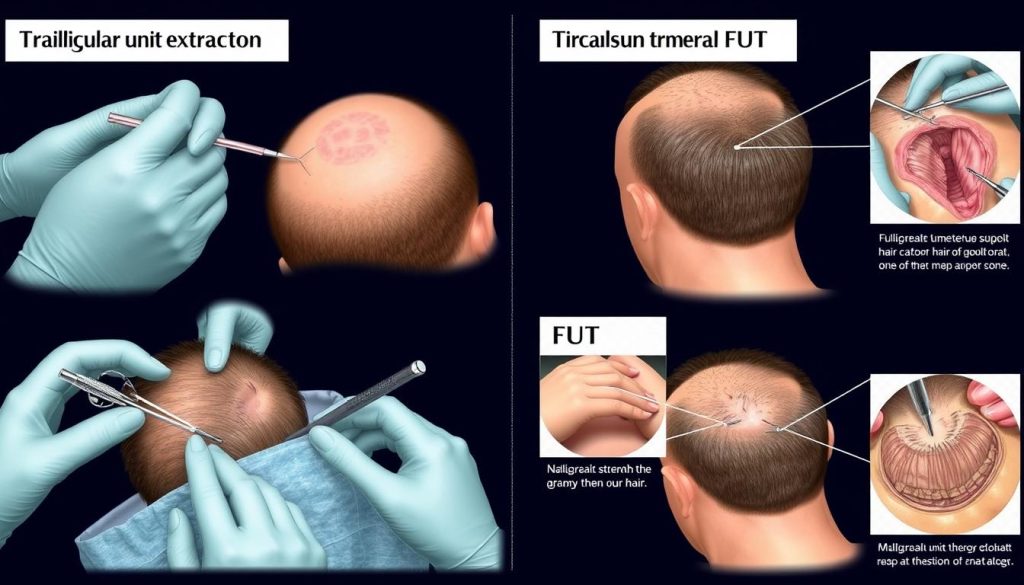
Follicular Unit Extraction (FUE) is a common choice. It takes hair follicles from the donor area and moves them to the recipient site. This method causes little scarring and has a quick recovery.
Follicular Unit Transplantation (FUT) is another option. It removes a skin strip with hair follicles from the back of the head. The surgeon then breaks this strip into individual grafts for transplant. FUT might leave a linear scar but is good for those needing many grafts.
| Procedure | Scarring | Recovery Time | Suitable For |
|---|---|---|---|
| FUE | Minimal | Shorter | Smaller areas, short hairstyles |
| FUT | Linear scar | Longer | Larger areas, longer hairstyles |
The NHS also looks into new hair restoration methods. These include robotic hair transplantation and scalp micropigmentation. Your surgeon will pick the best option for you based on your needs and hair loss.
Follicular Unit Extraction (FUE) Technique
Follicular unit extraction is a modern hair transplant method. It offers many benefits for those wanting to improve their hairline. This method is also very gentle.
Benefits of FUE Surgery
FUE surgery has several key benefits:
- Minimal scarring
- Quicker recovery time
- Natural-looking results
- Suitable for various hair types
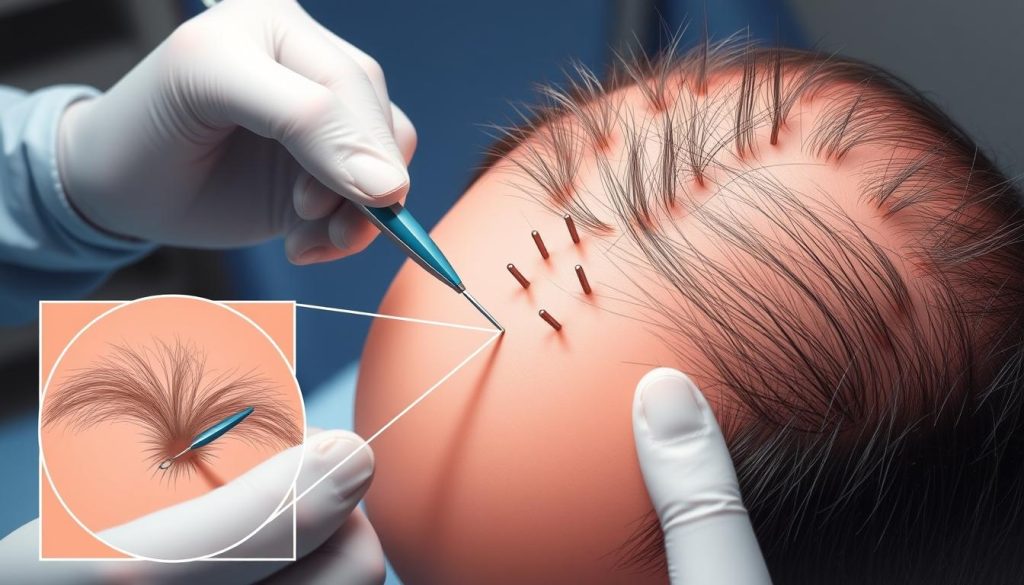
Procedure Steps and Duration
The follicular unit extraction process involves:
- Shaving the donor area
- Extracting individual hair follicles
- Creating recipient sites
- Implanting the harvested follicles
A typical FUE procedure can take 4-8 hours. This depends on how many grafts are needed.
Recovery Timeline
Recovery from follicular unit extraction is quick:
- Day 1-3: Mild discomfort and swelling
- Day 4-7: Scabs form and begin to fall off
- Week 2-3: Return to normal activities
- Month 3-4: New hair growth becomes visible
Full results are usually seen within 12-18 months after surgery.
Follicular Unit Transplantation (FUT) Method
Follicular unit transplantation is a well-known hair restoration method. It’s also known as the strip method. This technique involves taking a thin strip of scalp from the back of the head. The strip is then split into individual follicular units for transplanting.
- Allows for a larger number of grafts in a single session
- Typically faster than other methods
- Often more cost-effective for extensive hair loss
Even though FUT has its advantages, it does leave a linear scar at the donor site. This scar can be hidden by hair, but it might show with very short haircuts.
| Aspect | FUT Method |
|---|---|
| Procedure Duration | 4-8 hours |
| Recovery Time | 10-14 days |
| Scar Type | Linear |
| Suitable for | Extensive hair loss patterns |
The recovery from follicular unit transplantation needs careful care. Patients should avoid hard work for about two weeks after surgery. The area might scab and fall out at first, but new hair growth starts in 3-4 months.
“FUT remains a viable option for many patients, specially those needing a lot of grafts,” says Dr Sarah Thompson, a leading hair restoration specialist.
Follicular unit transplantation is good for many hair loss patterns, mainly for those needing a lot of coverage. It’s important to talk to a skilled surgeon to see if FUT is right for you.
Private vs NHS Hair Transplant Treatment
Choosing between private and NHS hair transplant treatments involves weighing several factors. This comparison helps you understand the key differences to make an informed decision.
Cost Comparison Analysis
Hair transplant cost varies significantly between private clinics and the NHS. Private treatments can range from £3,000 to £15,000, depending on the extent of hair loss and chosen technique. NHS treatments, when available, are typically free but limited to specific cases.
| Provider | Cost Range | Availability |
|---|---|---|
| Private Clinics | £3,000 – £15,000 | Widely available |
| NHS | Free (if eligible) | Limited availability |
Waiting Time Differences
Private clinics offer quicker access to hair transplant procedures, often scheduling within weeks. NHS waiting times can extend to several months or even years due to limited resources and strict eligibility criteria.
Quality of Care Considerations
Both private and NHS treatments adhere to high standards. Private clinics may offer more personalised care and advanced techniques. NHS procedures, while excellent, might have less flexibility in treatment options.
When deciding between private and NHS hair transplant treatments, consider your budget, urgency, and specific needs. Private options offer speed and variety but at a higher cost, while NHS treatments provide affordability for those who qualify but with longer wait times.
Pre-operative Assessment and Planning
Before a hair transplant, patients must go through a detailed pre-operative assessment. This step is key to check if they are eligible for the procedure. It aims to ensure the best results for the patient.
A qualified surgeon will look at the patient’s scalp during the first meeting. They focus on the hair loss pattern and how much hair is available. This is important to create a plan that meets the patient’s needs and goals.
The pre-operative phase includes several steps:
- Scalp analysis to determine hair density and quality
- Medical history review to identify any risks
- Blood tests to check for health conditions
- Discussion of realistic expectations and desired outcomes
Patients might need to make lifestyle changes before the surgery. This could mean stopping smoking or changing medication. These steps help make the transplant more likely to succeed.
This time is also for patient education. Surgeons will explain the procedure, talk about possible risks, and give care instructions. This ensures patients are well-prepared for their hair transplant journey.
Post-operative Care and Recovery Guidelines
Proper care after a hair transplant is key to great results. It’s vital to follow certain steps to help your hair grow well.
Immediate Aftercare Instructions
Keep the treated area away from sunlight and don’t touch or scratch it. Sleep with your head up for a few nights to reduce swelling. Clean your scalp gently as your surgeon tells you to avoid infection.
Long-term Maintenance Requirements
Use soft hair care products and stay away from harsh chemicals. Eat well, with lots of vitamins and minerals, to help your hair grow. Regular check-ups with your surgeon are important to track your progress and solve any issues.
Potential Complications
Though rare, some problems can happen during recovery. Look out for signs of infection like too much redness, swelling, or discharge. Some might see temporary shock loss, where hair falls out before new growth starts. If you see anything odd, get in touch with your doctor right away.
“A successful hair transplant recovery requires patience and careful adherence to post-operative instructions.”
By sticking to these guidelines, you can have a smooth recovery and get the best from your hair transplant.
Expected Results and Timeline
Knowing when to expect hair transplant results is important. The journey to a fuller head of hair takes time. It has different stages that show progress.
At first, the transplanted hair might fall out in 2-3 weeks after surgery. This is normal and temporary. New hair starts growing around 3-4 months, with clear signs of improvement by 6 months.
It usually takes 12-18 months to see the full results of a hair transplant. How fast you see results depends on several things. These include how much hair you’ve lost, how many grafts you got, and how well you heal.
| Timeline | Expected Results |
|---|---|
| 0-3 months | Initial shedding, scalp healing |
| 3-6 months | New hair growth begins |
| 6-9 months | Noticeable improvement in density |
| 9-12 months | Continued growth and thickening |
| 12-18 months | Final results visible |
Being patient is essential when waiting for hair transplant results. While it may take time, most people are very happy with their results. Regular check-ups with your surgeon help with healing and answer any questions you might have.
Alternative Hair Loss Treatments on NHS
The NHS has many hair loss treatments beyond transplants. These options meet different needs and preferences. They are for those who don’t want surgery.
Medical Treatments
NHS doctors can prescribe medicine for hair loss. Minoxidil, a lotion or foam, helps hair grow when applied to the scalp. Finasteride, a daily pill, stops male pattern baldness by blocking a hormone.
Non-surgical Options
For those who don’t want medicine, the NHS might suggest scalp micropigmentation. This cosmetic method makes the scalp look fuller by tattooing pigment. Hair systems, like wigs or hairpieces, are another way to cover bald spots or thinning areas without surgery.
Combination Therapies
The NHS might recommend using treatments together for better results. This could mean using minoxidil and finasteride together. Or, it might suggest pairing medical treatments with a hair transplant for a complete solution.
| Treatment | Type | Effectiveness | Side Effects |
|---|---|---|---|
| Minoxidil | Topical | Moderate | Scalp irritation |
| Finasteride | Oral | High | Decreased libido |
| Scalp Micropigmentation | Cosmetic | Immediate visual effect | Fading over time |
| Hair Systems | Non-surgical | Instant coverage | Maintenance required |
Success Rates and Patient Satisfaction
Hair transplant success rates have gone up a lot in recent years. Many patients are very happy with the results. The success of these procedures depends on the surgeon’s skill, the technique used, and the patient’s own characteristics.
Research shows that FUE and FUT techniques have high success rates. They usually range from 85% to 95%. This means most of the transplanted hair grows well in the new area. Many patients feel more confident and have a better quality of life after the procedure.
| Technique | Average Success Rate | Patient Satisfaction |
|---|---|---|
| FUE | 90-95% | Very High |
| FUT | 85-90% | High |
Even though these numbers are good, results can vary for each person. Things like age, health, and how much hair you’ve lost can affect the outcome. It’s important to talk to your surgeon about what you hope to achieve.
“My hair transplant changed my life. I feel more confident and youthful now. The results exceeded my expectations.” – Anonymous Patient
To get the best results from a hair transplant, follow your surgeon’s advice after the procedure. Also, keep up with regular check-ups. This helps make sure you’re happy with the results for a long time.
Choosing the Right Hair Transplant Surgeon
Finding a skilled surgeon is key for a successful hair transplant. The NHS has qualified doctors. But, knowing what to look for helps you choose wisely.
Qualifications to Look For
A good hair transplant surgeon has certain qualifications. They should be members of groups like the British Association of Hair Restoration Surgery (BAHRS) or the International Society of Hair Restoration Surgery (ISHRS).
Experience Assessment
Experience is important for a successful surgery. Check how many surgeries the surgeon has done. Also, ask about their experience with FUE or FUT methods.
| Experience Level | Procedures Per Year | Years in Practice |
|---|---|---|
| Novice | 50-100 | 1-3 |
| Intermediate | 100-200 | 3-5 |
| Expert | 200+ | 5+ |
Patient Reviews and Testimonials
Reading what other patients say can help. Look on the NHS website or ask your GP. Good feedback from others shows a surgeon’s skill.
By looking at these points, you can find a skilled NHS surgeon for your hair transplant.
Long-term Maintenance and Follow-up Care
After a hair transplant, it’s important to take good care of your hair. The recovery process goes on for a while, needing ongoing care.
It’s vital to keep up with follow-up appointments with your transplant team. These visits help doctors check how you’re doing and solve any issues. Usually, you should see them at 3, 6, and 12 months after the surgery.
- Gentle washing with specialised shampoos
- Avoiding harsh styling products
- Protecting the scalp from sun damage
- Maintaining a healthy diet rich in vitamins and minerals
Some people might need extra treatments to keep their hair looking good. These can include:
| Treatment | Purpose | Frequency |
|---|---|---|
| Minoxidil | Promote hair growth | Daily |
| Finasteride | Prevent further hair loss | Daily |
| PRP therapy | Stimulate hair follicles | Every 3-6 months |
For lasting results, focus on your scalp’s health. This means managing stress, eating well, and avoiding bad habits like smoking.
Latest Innovations in Hair Transplant Technology
The world of hair restoration surgery is changing fast. New technologies are making treatments better and safer. Robotic hair transplantation is a big step forward. It allows for very precise hair planting, cutting down on mistakes and recovery time.
Stem cell therapies are also making waves. Scientists are looking into using stem cells to grow new hair follicles. This could change hair loss treatment forever, even for severe cases.
Hair cloning is another exciting idea. It’s like growing more hair in a lab and then planting it. If it works, it could give patients endless hair, solving a big problem in hair transplants.
These new ideas might change how the NHS does hair transplants. They could make treatments faster and more effective. People looking for the latest in hair surgery might get to try these new methods in clinical trials.
FAQ
Q: Is hair transplant surgery available on the NHS?
A: Yes, the NHS offers hair transplant surgery. But it’s mainly for those who lost hair due to injury or scarring. The NHS focuses on medical needs, not just looks.
Q: What are the eligibility criteria for an NHS hair transplant?
A: To get an NHS hair transplant, you must have lost hair due to burns, injuries, or certain health issues. Feeling stressed about your hair isn’t enough. Each case is judged on medical grounds.
Q: How long is the waiting time for an NHS hair transplant?
A: Waiting times for NHS hair transplants vary. It depends on where you are and how many resources are available. Some may wait months or even a year. Urgent cases get priority.
Q: What hair transplant techniques are used by the NHS?
A: The NHS uses two main techniques: Follicular Unit Extraction (FUE) and Follicular Unit Transplantation (FUT). The choice depends on your case and the surgeon’s advice.
Q: How much does a private hair transplant cost compared to NHS treatment?
A: Private hair transplants cost between £3,000 and £15,000. This depends on how much hair you’ve lost and the technique used. NHS transplants are free for those who qualify, but there are strict rules.
Q: What is the recovery time after an NHS hair transplant?
A: Recovery time is different for everyone. Most can go back to work in 1-2 weeks. It takes several months for the hair to fully grow back. Regular check-ups are important.
Q: Are there any alternatives to hair transplant surgery offered by the NHS?
A: Yes, the NHS offers other treatments. These include medicines, scalp micropigmentation, and hair systems. They might be suggested based on your hair loss.
Q: What are the success rates for NHS hair transplants?
A: NHS hair transplants often work well, with many seeing a big improvement. But results can vary. This depends on how much hair you lost, the quality of the donor hair, and aftercare.
Q: Can I choose my own surgeon for an NHS hair transplant?
A: You can say who you’d like to do your transplant, but the NHS usually decides. You can check the surgeon’s qualifications and experience.
Q: Are there any age restrictions for NHS hair transplants?
A: There’s no strict age limit for NHS hair transplants. But surgeons often prefer patients whose hair loss has stopped. This is usually around 25 or older for men.













